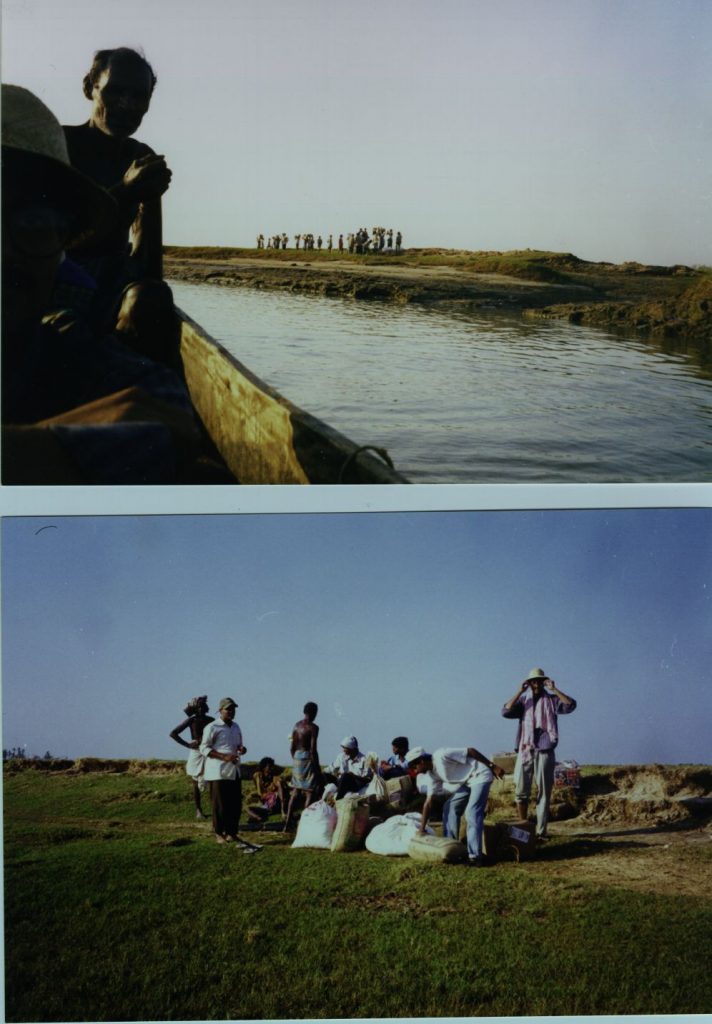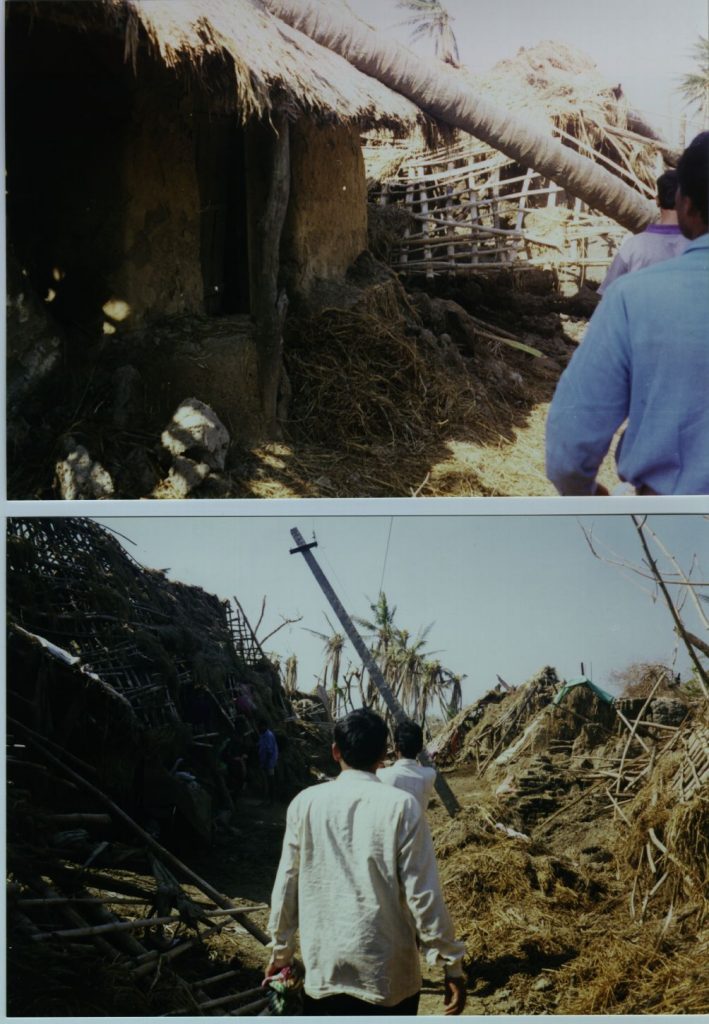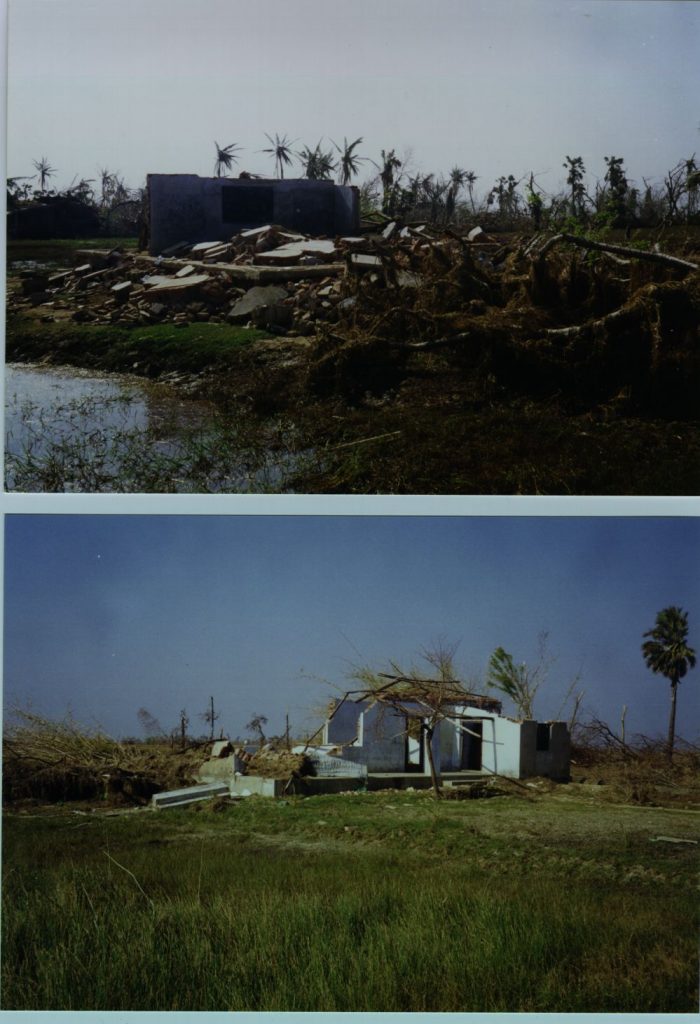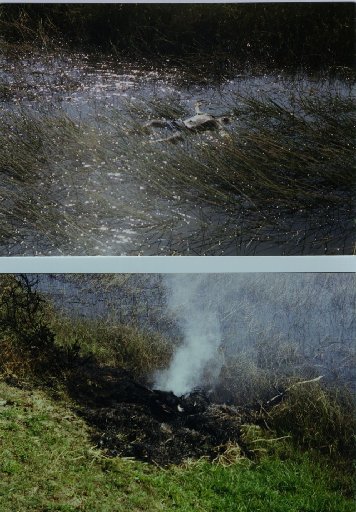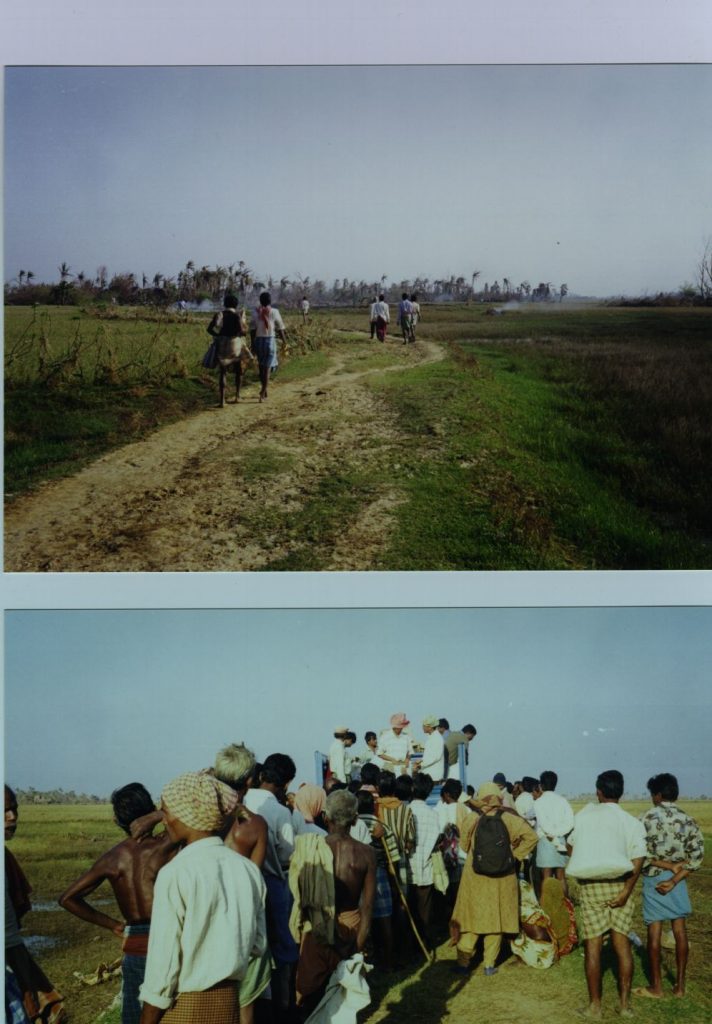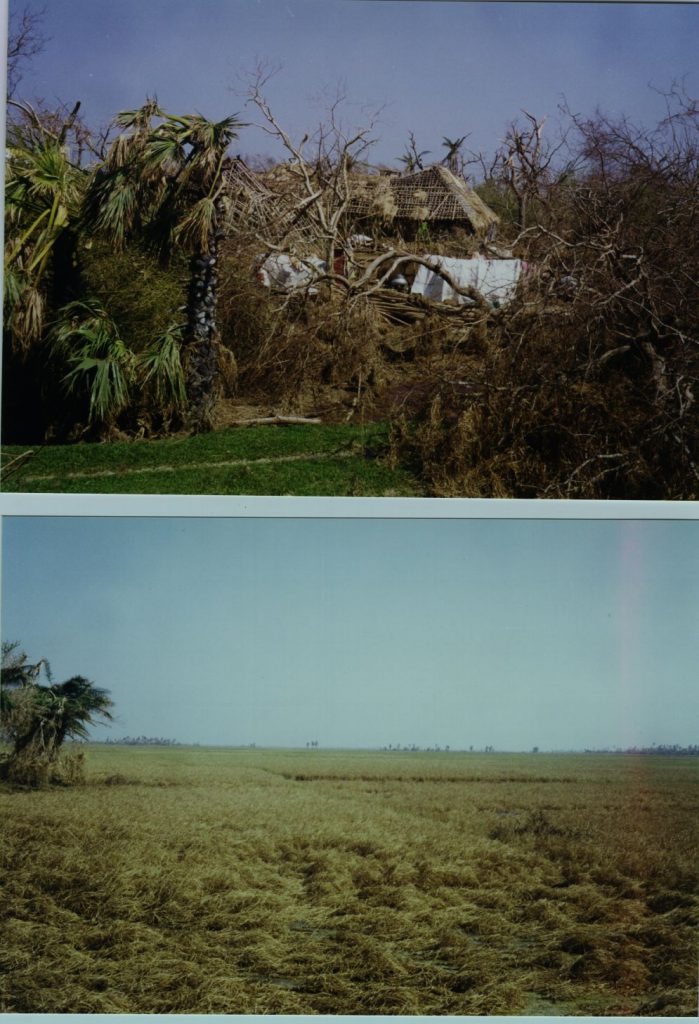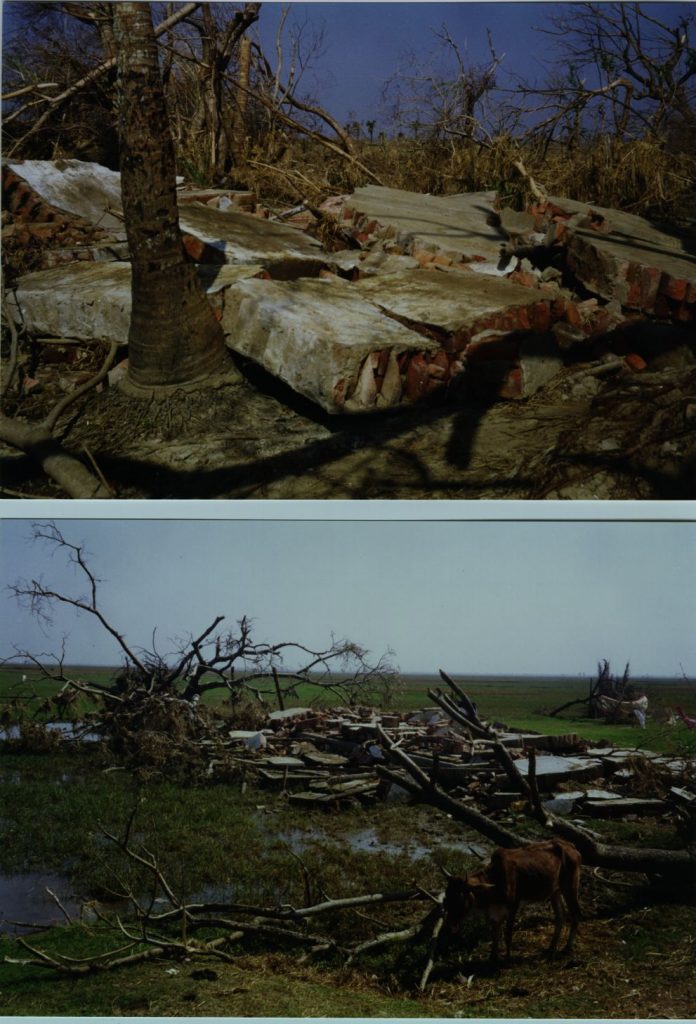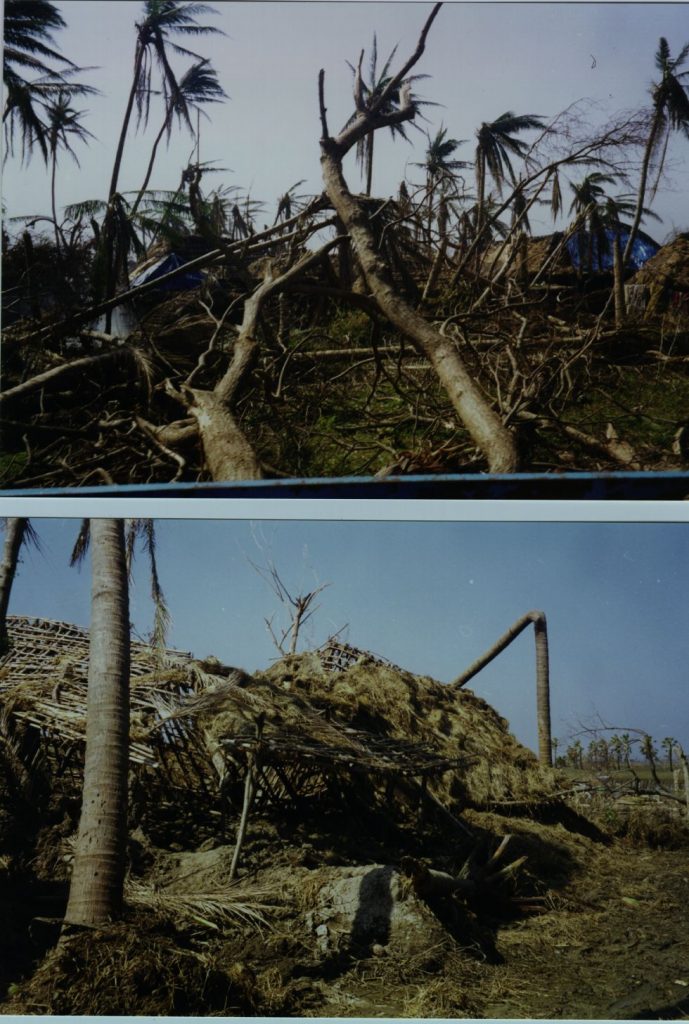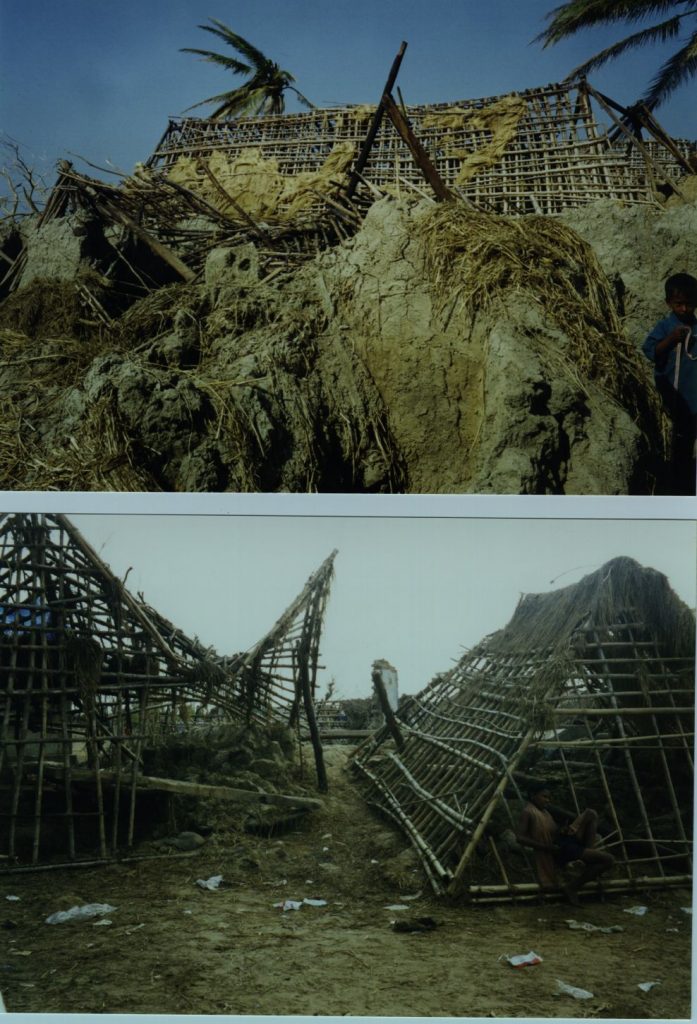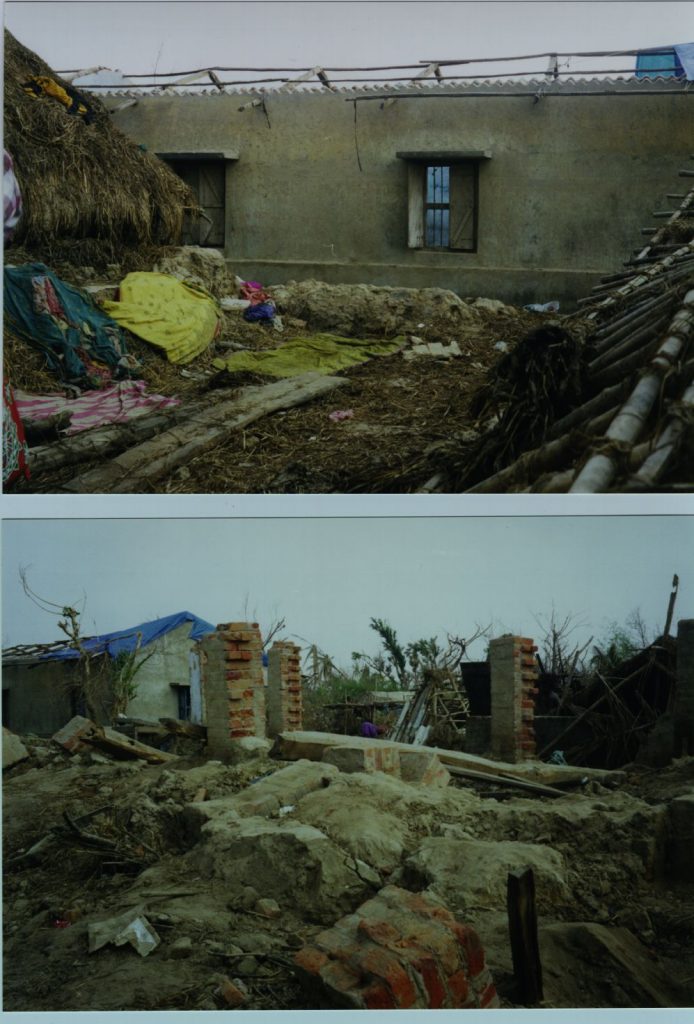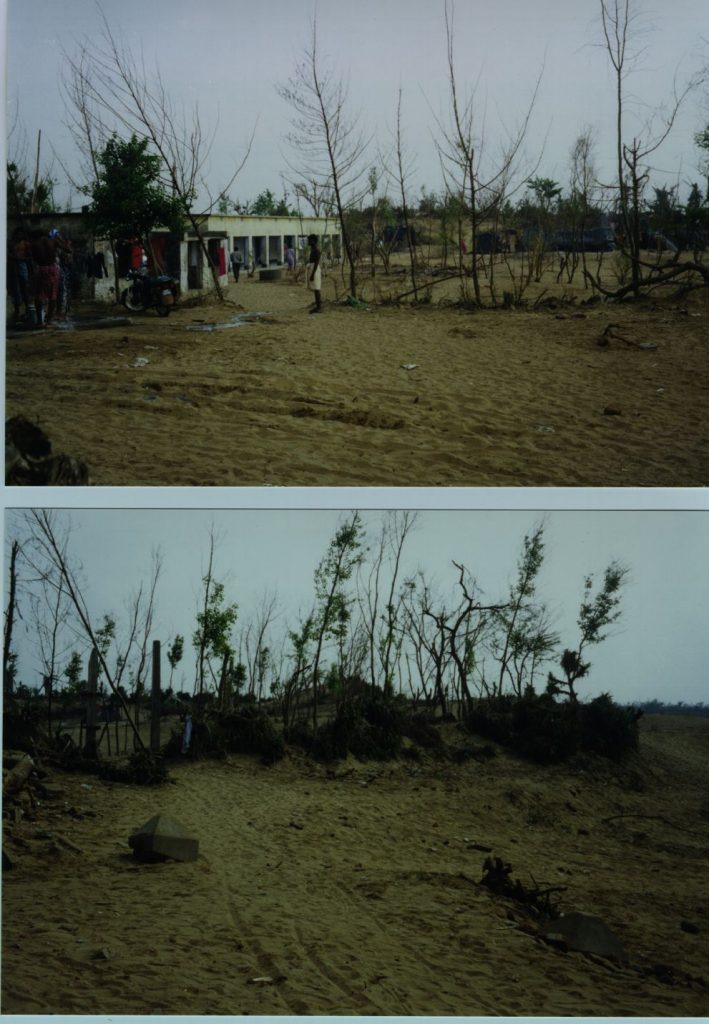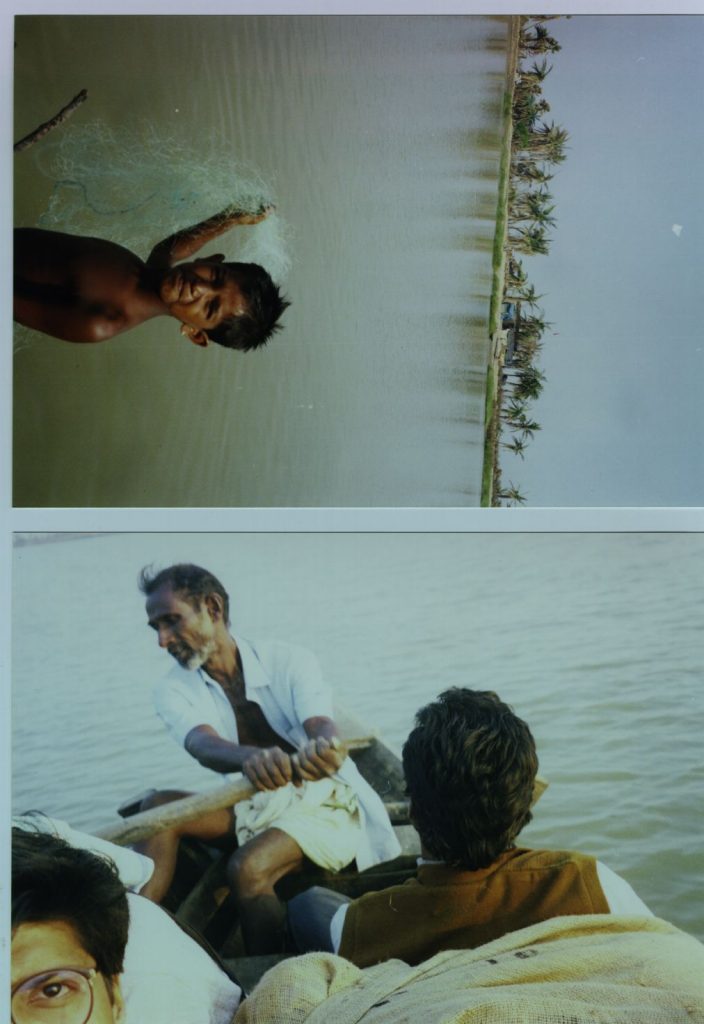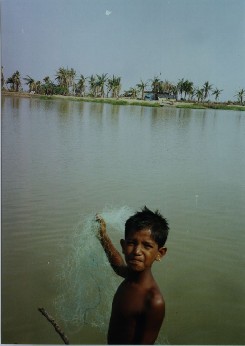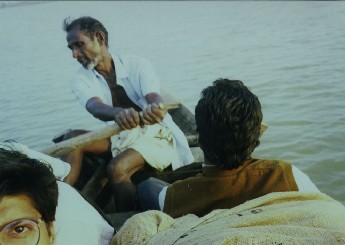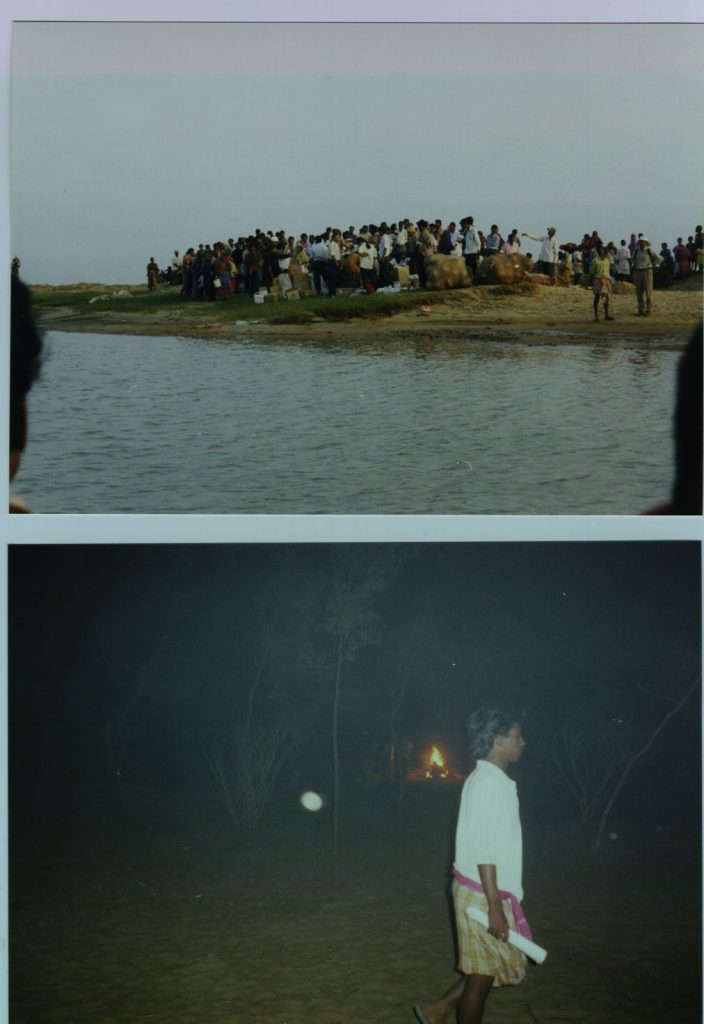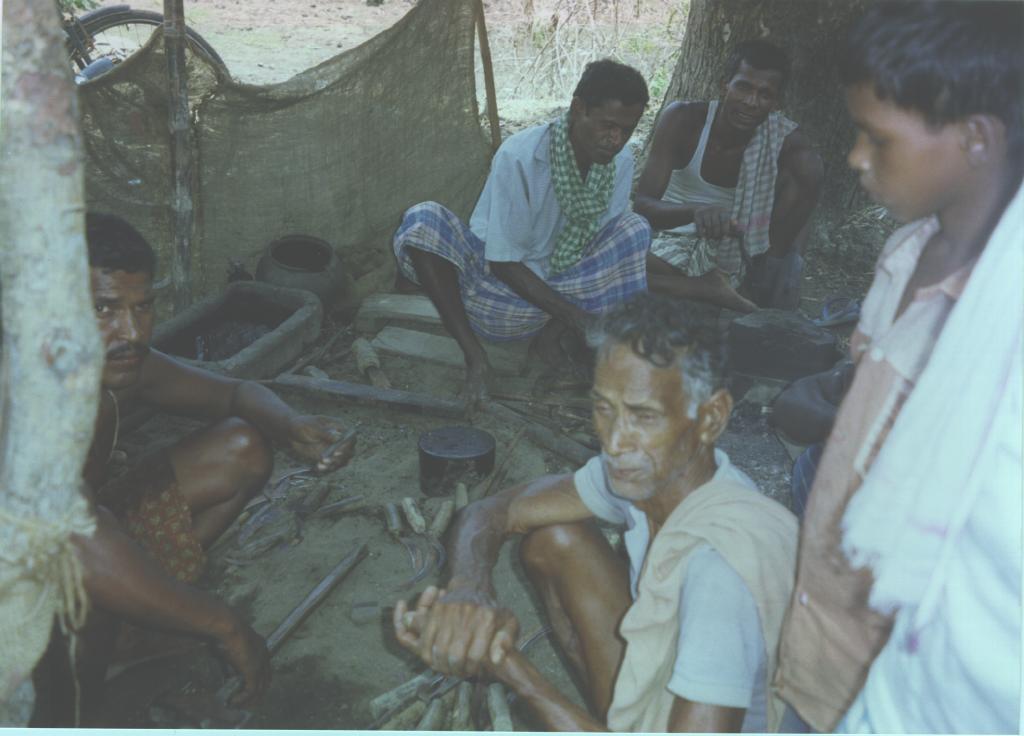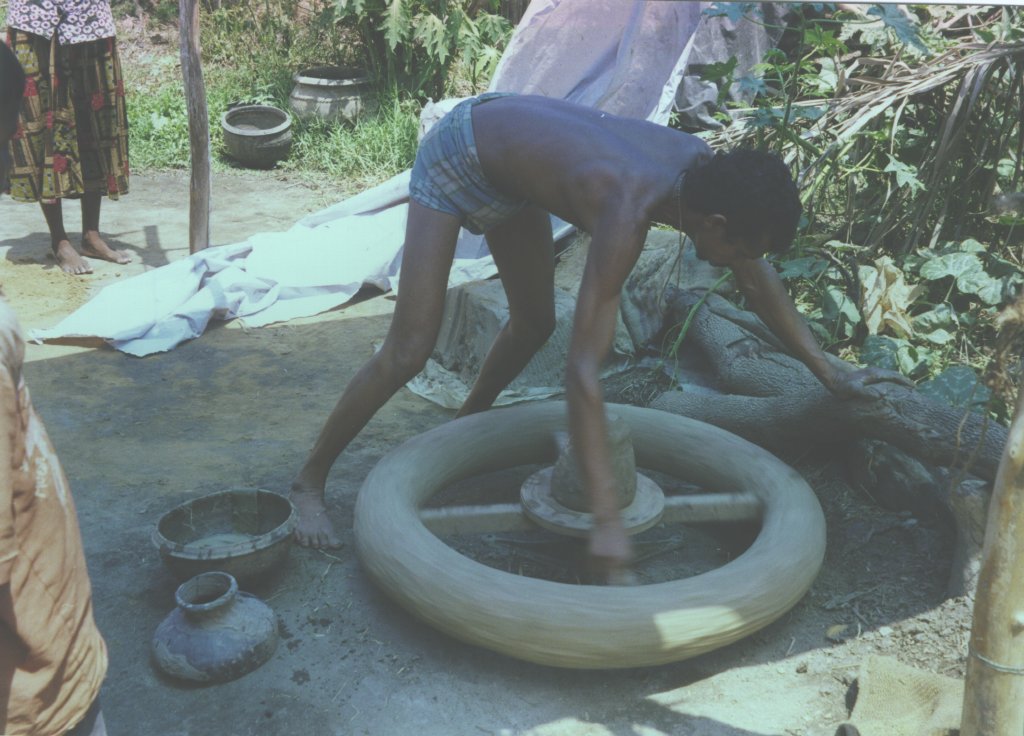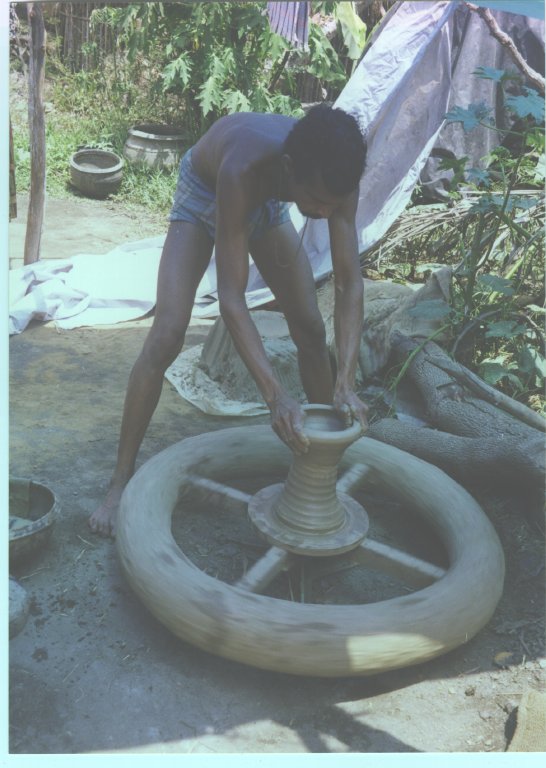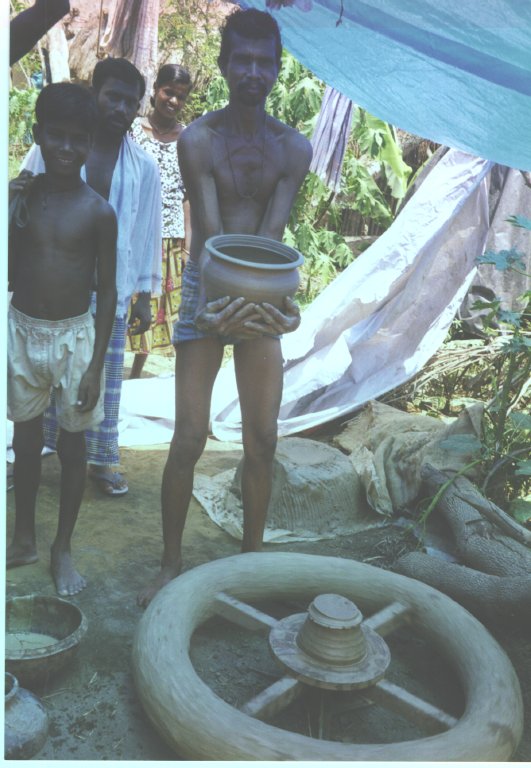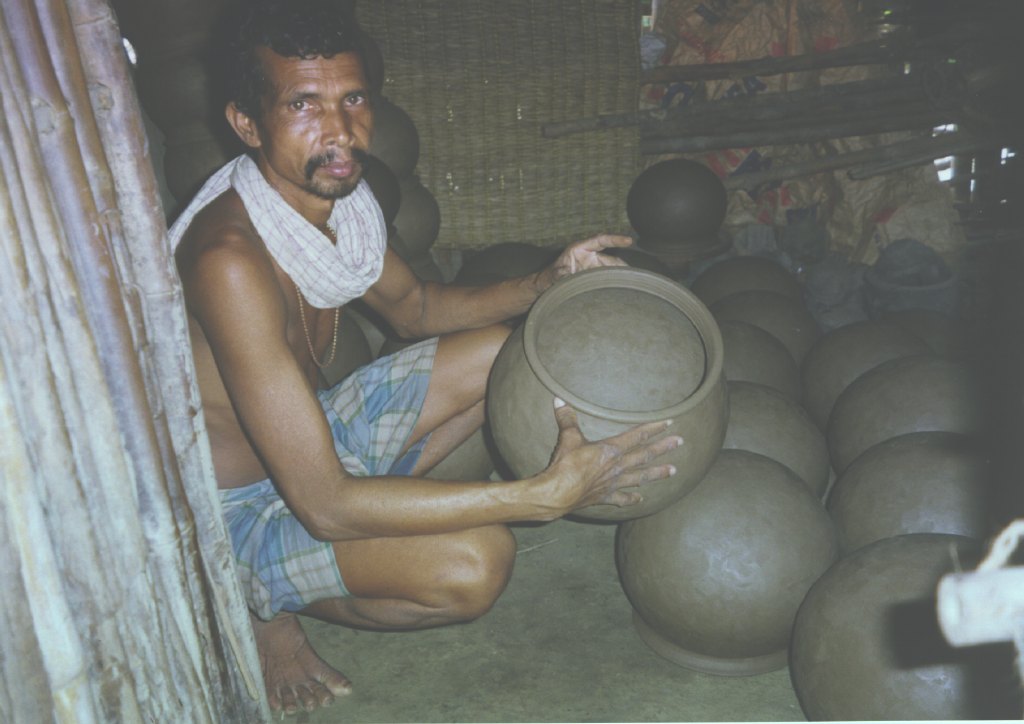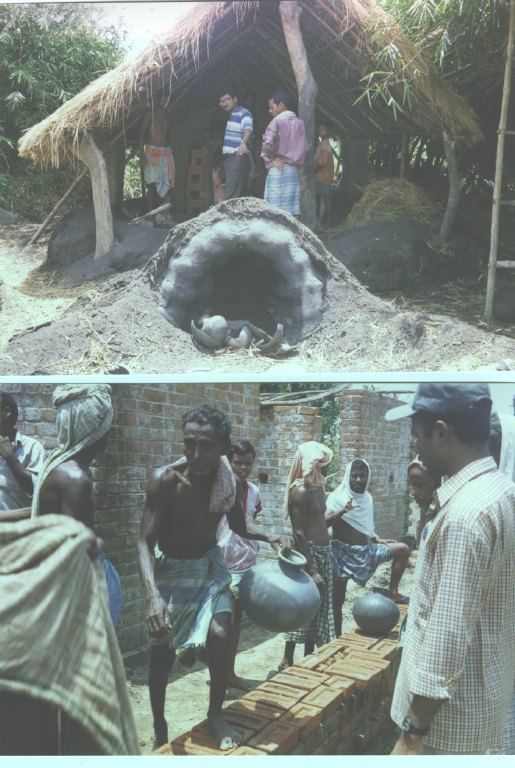Orissa Super Cyclone: 29th Oct. 1999
There were several relief operations in villages of Orissa hit by super cyclone, carried out by some volunteers at the Institute of Physics, Utkal University(Physics Dept.), Benaras Hindu University(Physics Dept.) and Tata Institute of Fundamental Research, with support from various other Institutes in India and abroad. The volunteers give their reports here.
1. Report on the relief work carried out on 7-11-99
We have collected about Rs. 20,450/= from our Institute members (Soon, a complete list of the contributors will be put on Institutes webpage) and Mehta Reserch Institute has collected about Rs 40,000/=.
On 7.11.99, we (about 18 Institute members, most of them are Scholars/faculty) went to Nuagad and Nagar Panchayats, in Astaranga block (Puri Dist.). We bought Rice, Dal, Sugar, Flattened Rice (Chuda), Biscuits, Milk Powder, Candles, Match boxes, Electrol Powder packets, Raw Lemons, Polythene Sheets, old cloths, water bottles (collected from various peoples) etc. On 6th November, khichdi was prepared (about 1500 kg) and about 500 packets were made. Similarly, about 500 packets of Chuda has been made (each packet consists of a lemon, about 350 g of Chuda and 100 gm of sugar). All these were done in candle light in the early hours of 7th Nov. We got a mini truck from Army (thanks to Col. Balwinder) with two army people as escort. Loaded vehicle with 15 scholars, 2 faculty, 1 auxiliary staff and all the items mentioned above left the Institute about 7.45 AM. We reached Nuagad around 12:30 PM after various stops and discussion with army people. We decided to go to Nuagad and Nagar panchayats after the briefing by Army people.
We distributed major part of the khichdi in Nuagad. The distribution has been carried out with individual supervision. Also, the goods were carried through hostile environment (filled with dead animal bodies) for about 2 km and then by a country boat (for 30 minutes) and 2-3 km in marshy area. The local people also helped us in carrying the goods. We distributed the materials in both Nuagad and Nagar panchayats. We feel that the effort we have put in is worth doing. It could be a just drop in the ocean, but about 500 people might not starve for about a day and can see the light in the dark. With a lot of enthusiasm and will power, we would like to do much more than what we have done. We will let you know our future program in another mail.
- Volunteers at IOP
2. Report on the relief work carried out on 14-11-99
From IOP, most of the scholars, two faculty, six from administrative/technical section, two from Institute security, one from C&S, along with three faculty from Utkal University, one from Banaras Hindu University (alumni member), three Army personnel, were involved in the relief work that was carried out on 14.11.99.
We have collected about Rs 70,000/= from Institute members and Mehta Research Institute has made arrangements to send about Rs 40,000/=. In our first relief work on 7.11.99, we have spent about Rs.28,000/=. This time, on 14.11.99, we have spent about Rs 85,000/=. Some of us have put in some buffer money to cover the expenses.
On 13-11-99, some of the volunteers visited the affected places, talked directly to the people, and made a survey report about the requirements of the people over there. It is a strenuous 5 hr journey first by road (a distance of about 10 km at the end, took nearly 2 hours by a small trekker, which is a kind of jeep) and then few km walking to the villages. The survey team made a list of five villages where relief materials were badly required. We are taking the help of Sarvodaya Organization and Kasturba Gandhi National Memorial trust (Utkal) who have setup their relief camp (a community feeding center and 10 bed makeshift hospital). On 13.11.99, when we went to survey the area around Nuadighi, we provided milk powder, bleaching powder, biscuits, water purifying tablets, Electrol, suji and sabudana for patients. We took Nuadighi as center for our survey and went to villages which were not easily accessible. On the way, the bridges had collapsed and at some places coconut stems have been used as ladders connecting to the broken bridges and one place we had to cross by country boat. We learnt from the survey, that about 200 families (each with 8-10 members on average) in five villages (all the families who were lucky to survive) needed relief materials to stay on in the hot sun in the day and chilly weather in the night under the open sky. As most of the trees are uprooted, the people who are already devastated have no protection from the cold wind. The villages which were selected for relief work were: Chandapur, Mathasahi, Mirjapur, Dhuansahi, and Khapuria. There are about 65 families in Chandapur and Mathasahi, about 40 – 45 families in Mirjapur, Dhuansahi and Khapuria each.
On 14.11.99 (Sunday), about 25 of us started in a trekker and a mini truck (provided by Army) with three Army personnel. We carried about 200 sarees, 200 chaddars (bedsheets), 100 gumchhas, 100 lungis, 250 polythene sheets, 2000 biscuit packets, 200 milk powder packets (each 200gm), about 160 kg flattened rice (chuda), 350 kg rice, 100 kg Dal, 100 small lamps (made using small bottles: the bottles were collected from the Institute members, cleaned and dried properly, and holes were made on the caps and finally a cotton thread was fitted) etc. We reached a point about 3 km from these villages beyond which vehicles could not go.
As we wanted to make sure that supplies reached every needy family in these four villages (Chandapur and Mathasahi being one, and the rest three being Mirjapur, Dhuansahi and Khapuria), we used the following procedure. We formed four groups, with each group consisting of about 4-5 of us (the volunteers). We tried to talk to family members of each family and tried to console them (as much as we could). It is shocking to see the school buildings completely shattered on the ground, and all thatched houses blown away by the wind. Even after 15 days from the day the Cyclone hit, the villages have not recovered even slightest. We saw people sitting on top of the collapsed huts, not knowing what to do. They do not have any shelter to protect them from the cold wind of the night, or hot sun in the day, and one can only pray that it does not rain. We were told that the sea water had rushed into the villages upto a height of about 5-6 ft. Force of water could only be imagined, as these villages are about 20 km from the sea. We could see the marking of water level on the few trees which could resist the fury of the wind and the force of the sea and rain water. When we walked into the villages, one could see signs of death all over the place. There were lot of animal carcasses still lying around, very few of them being burnt. It was shocking to see human bodies still lying scattered in these villages, even after 15 days of the disaster. There were one or two tube wells in the villages, which provided precious water.
After talking to each family member, we handed over the coupons (one coupon per family). In some cases we also noted special needs on the coupon, for example, number of small children etc. This distribution of coupons took us 2-3 hours. Then people from the villages came with the coupons to the place where our mini truck was standing. We gave one saree, one bed sheet (chaddar), one gumchha/lungi, one lamp, one matchbox, 5-6 biscuit packets, milk powder packet, one polythene sheet, one chuda packet, etc., per family. To the ward members of the villages, we also gave water purification tablets. As Sarvodaya organization and Kasturiba Trust are being actively involved in feeding centers & medical necessities around the affected areas , we gave 350 kg of rice, 50 milk powder packets, 100 lt of diesel (to burn carcasses), water purifying tablets, 50 kg of Chuda, 5 bedsheets (chaddars), 10 sarees, 10 lt. of kerosin etc.
It was heartbreaking to listen to people’s experiences, loss of their loved ones in front of their eyes, and complete destruction of their property, all this just in a span of 20 hours of nature’s fury. Two weeks after the deadly cyclone, the ocean is silent and has taken back its water. One can see some shoots on the few trees standing. Some people have started building their homes in an attempt to start a new life, in a literal sense. It was moving to hear the story of a little girl (about 10 years old) who survived by clinging to a tree, carried by ocean waves from some far away place. She was rescued by the people from these villages. She has no memory of her family or where she comes from. She stood in the line alone to take supplies for herself. What happened was like a cruel dream. It may take 20 years to come back to the same state as it was before 20 days back. The people seem to have come to terms with the nature’s fury and are trying to start rebuilding their homes. What we (all of us) have given could be just a drop in the ocean, but this drop could sustain their life for few days in this winter helping them cope with hot days and cold nights. We feel, in our limit we have done whatever we could do. There were few smiles and sighs of relief, may be just to reflect they got some thing they were looking for badly, or maybe some words of consolation. We were trying to explain to one villager why we could not give him more, when another villager told him, let us be happy we got something.
It was a team work. Each one of us worked very hard and with a team spirit, without which the task could never have been completed. We feel that our effort in visiting their homes (or, where their homes used to be), will help them in surviving a few more days. We can only hope that the affected people will soon get the much needed supplies from other NGO’s and the government. We will continue to do our bit towards this. As and when we get more resources, we will make more trips, to different areas. We will keep using our experiences from the past trips to make the next trip more effective.
Thanking you all those who have helped (directly or indirectly) in this task.
- Volunteers at IOP
3. Report on the relief work carried out on 23-11-99
This was the third trip we had undertaken for the relief work in cyclone affected areas. There were 29 volunteers, most of them from IOP (including 4 IOP security guards) along with three volunteers from the Utkal University, who went for the trip. Also, a group of volunteers worked at IOP for days before the trip, sorting out used clothes, making bundles for each family, cutting plastic sheets for each family, and then in taking care of meals etc. of the teams which went on the trip.
We had received many messages from friends abroad mentioning that they are sending financial help for these relief operations. In view of these contributions, we pooled the money from people at IOP, UU required for this trip. In this trip we spent about Rs. 104,000/. We also got a huge supply of used clothes from IISc Bangalore which was collected by the students of IISc from all over Bangalore city. About 100 volunteers had worked for about 10 days at IISc in collecting the clothes from the city and in sorting them properly.
As last time, we first sent a team on 21-11-99 for surveying the area which we had tentatively chosen for the relief operation (by collecting information from different sources, primarily from Survodaya members). The survey team, consisting of eight volunteers went to several villages in Erasama dist. which is the worst affected area. They went to Kunjakothi and surveyed villages falling under four wards, ward no. 13,14,15 and 16. These areas had just become accessible by road. (In the morning, the survey team had to take a long detour to reach these villages, by trekker, and then by walking. While returning, the broken road had been repaired by the Army people, so they could come back by that road.) The members of the survey team talked personally to the people in these villages, and collected information about their most urgent needs. As Erasama area has received much focus, due to being the worst affected area, some supplies had reached most places in this area. For example, basic food material (rice and daal) was available to people. However, even after more than three weeks of the cyclone, they had received no plastic sheets (for making even a temporary shelter), or blankets etc.
Based on the report of the survey team, we purchased the required material for all 250 families under these four wards. We took three minitrucks, and one ambassador car with us for the trip. Material taken with us was, polythene, lamp, old clothes, milkpowder, 2 chaddars, and utensils (1 degchi, 1 thali, 1 mug) for each of 250 families (milk powder was for small children). We started loading material on the trucks at about 5:30 a.m., and started our trip at about 7:00 a.m. We stopped for little while at Cuttack at the Survodaya center, as we are coordinating with the members of Sarvodaya and Kasturba Gandhi National Memorial trust (Utkal). They have also set up a relief center at Kunjakothi and we took their help in distributing supplies to the individual families in that area.
Our plan was to reach Kunjakothi, distribute material to families there, and then proceed further closer to the ocean, to a village Khuranta which suffered even worse devastation due to being closer to the sea. Some distance before Erasama, we stopped to take lunch, since it would have been difficult to eat later due to the stench from rotting carcasses. At that time the convoy of the Governor of Orissa passed by us. When we continued our journey, our trucks, along with many other relief vehicles were stopped, before Erasama, as “the road had to be cleared for Governor’s vehicle”. We tried to convince the police inspector that we are carrying relief supplies and if it gets late, we will not be able to go to the deeper areas. However, they said that they are helpless. We had to wait there for one hour (and consequently, we could not go to Khuranta village, as it had become dark by the time we finished our distribution work at Kunjakothi).
During this time, some of the volunteers, who had gone ahead in the car, had arranged for two armed police escorts for us from Erasama. At Erasama, we were told that much supplies are reaching Kunjakothi and that we need not go there. We were told that three large Red Cross trucks had gone to Kunjakothi that day itself. We, anyway, proceeded towards Kunjakothi with the apprehension that if the supplies are not needed there, then we will try to go somewhere else. Few km down the road, after crossing a bridge repaired by the army, we reached a point after which the vehicles had to go on a (very) rough road. We saw the three Red Cross trucks at that place, and few people (from Kunjakothi) who were carrying blankets from those trucks.
We had to travel for about 45 minutes on this (badly) broken road before reaching Kunjakothi. We again followed the procedure of the coupons to make sure that the supplies reached every needy family in those villages. We formed four groups, with each group consisting of about 3-4 of us (the volunteers), covering the four wards. We visited each and every family and after talking personally with the members of the family, we gave one coupon per family to one of the family members. We noted special needs for the families on the coupon, such as whether there is any child less than 2-3 years age (for giving milk powder) etc.
Giving coupons to each family in some of these areas was not easy. For example, in ward no. 16 (called as Ajgarbedi) the houses/huts were literally washed away. There was no structure standing there and even collapsed remains could not be seen (which we could see at some other places in Kunjakothi as well as the earlier places we visited). Ajgarbedi is closer towards the ocean (by about 3 km), with ocean about 3-4 km away. The tidal wave had not only taken away the entire houses (huts) with it, it had even dug a large pit in the area where the huts used to be. There was literally no sign left of a dwelling. At some of those places, we found the “evidence” of a house in few torn pages from a geometry book, and torn clothes, that had gotten stuck in the ground. Out of about 400 people in Ajgarbedi, only about 200 remain. Rest were simply washed away by the 20 ft. high wave on that fateful morning of 29th Oct.’99. The powerful waves had left signs, in the form of large pits where the houses used to be, in form of hay which can be seen stuck at the height of about 20ft on the trees (which are still standing). Mere thought of 20 ft powerful wave engulfing the entire village makes you afraid of the word cyclone now.
The people who remain, have made settlements on the road in the form of small tents covered with clothes/plastic sheets. In many tents, there are 3 -4 families staying together. Many families have only 1-2 members left. We met a young boy of age 17-18, who has lost his father,mother and sisters in this cyclone. He is working now with Survodaya, busy helping the relief organizations in carrying material to people of that area. We took help of some such people in identifying individual families, and then gave them the coupons. There was a girl of age 10. She was the only member of her family left. We gave her the coupon, we added milk powder (though meant for children below age 2-3), we added blanket (meant for elderly), and that is all we could do for her. We were told about a family where only one child has survived. The child had gone to play with children in another family. They took him to the Red Cross shelter with them. When they came back there was no one left. Another family was completely washed away, with the only survivor being a young boy who studies in Raurkela. The devastation these people have suffered makes any relief effort look hopelessly inadequate. In the civilized world, when one member of a family dies, all near and dear ones gather to console the grieved family. Here, every family had lost 3-4 members. All they are able to get is some rice, daal, an extremely congested place in the tent to sleep, and these too weeks after the disaster.
The distribution of coupons took us 2-3 hours. It had started getting dark. People from the villages came with the coupons to the place where our mini truck was standing. To each family, we gave a bundle of used clothes, one small Kerosin lamp with glass cover (kerosin was available there), one plastic sheet, one mat, utensils (one handi, one mug and one thali), and two chaddars. For elderly we gave blankets. To each family with small children (less than 2-3 years of age) we gave 1 kg box of milk powder. By the time distribution ended, it was dark and we dropped the idea of going to Khuranta. We had brought clothes for Khuranta, which (including some woolens) we gave to Kunjakothi ward members for distribution.
Every time we go for a trip we see a new level of devastation. The images of complete villages being literally washed away are etched in the large pits left where the houses used to stand, in scattered bodies far away from these villages, in the few members of each family left behind, and forever in our memories. The tents, they have made, are in the middle of swamp, as sea water still fills the paddy fields on both sides of their settlements. Huge bunches of mosquitos could be seen filling their tents (it had started getting dark when we were coming back after distributing coupons). The diseases are bound to come in future unless sincere efforts are taken to prevent them. Someone has to care for these orphans who have lost their entire family in just a span of 24 hours. They need consolation, they need care, and most of all they need protection.
The needs of people in these areas are changing day by day. We will be going on one more trip in next couple of days (this time to some villages near Ambiki). We thank all of you who have helped us in this effort.
- Volunteers at IOP
4. Report on the relief work carried out on 1-12-99
This was the 4th trip we had undertaken for the relief work in cyclone affected areas. We spent about Rs. 1,50,000 in this trip. Earlier, we had spent about Rs. 28,000 in the first trip, Rs. 83,000 in the 2nd trip, and Rs. 1,05,000 in the third trip, with the total money spent in all the four trips being Rs. 3,66,000. Total money collected was about Rs.3,68,000, out of which, Rs. 88,000 was collected at IOP, Rs. 60,000 was collected at MRI (by Dr. Sumathi Rao), Rs. 13,500 at Matscience (by Dr. T.R. Govindarajan), Rs. 81,000 at Syracuse University, USA (by Dr. A.P. Balachandran), Rs. 10,500 at Hongkong (by Dr. Sundarvel), Rs. 16,500 at Sweden (by Dr. Supriya Kar), Rs.17,300 at Germany (by Dr. Sekar), Rs. 48,000 was collected at Singapore and Kuwait (by Mr. Haris and friends, contact via Dr. B. Sekhar), Rs. 6,500 at S.N.Bose Institute (by Dr. R.P. Malik), Rs. 8,500 from NY, USA (By Dr. Ujjwala Brahme), Rs. 9,000 from Japan (by Dr. Satyajit Behari). About Rs. 11,000 was contributed by individuals from different places (from BARC, PRL, TIFR, Utkal U., CBS Chennai, and NY USA). We had pooled in about Rs. 2,30,000 among us so that the relief work is not delayed till the money from outside reaches here. The money sent by people from outside Bhubaneswar has started reaching here now and is being returned (as it is coming) to people from whom the money was borrowed. Also, we had got a large supply of used clothes sent to us by the student council of IISc Bangalore. We have been sorting out and taking these clothes also in our last two trips.
Number of volunteers who went for this 4th trip was 26. Most of them were from IOP, along with three volunteers from the Utkal University (mostly scholars and faculty, plus one from administrative staff and four Institute security guards). Also, as in last trips, a group of volunteers worked at IOP for days before the trip, sorting out used clothes, making bundles for each family, making packets of items to be distributed to each family, and then in taking care of meals etc. of the teams which went on the trip.
There was a team of volunteers from BHU (one physicist and 5 medical students) who had come here on there way to the cyclone affected areas. On 28-11-99, we sent our survey team with them to Ambiki panchayat in the Ersama block. This area has been worst hit in this cyclone. The survey members (two volunteers from our team along with the team from BHU) went to Ambiki in a trekker. The people from BHU setup a temporary medical camp there (in the broken school building which they covered with tarpoline). They had taken medical supplies with them. The members of survey team then crossed the Hansua river (which is about 100 meter wide) in a small boat to go to Dahibara village. They also spoke to people from another nearby village Kankan. Dahibara and Kankan are not accessible by road, and one has to cross the river and/or (depending on water level in the river) walk 5-6 km to reach there. Ambiki itself has received supplies on a regular basis, and people from Dahibara, Kankan (and other nearby villages also) are able to come to these places to get some relief supplies of rice, daal etc. Survey members talked to people at Dahibara. Due to time constraints, they could not go to Kankan, but they gathered information about the needs of that village. There were about 130 families at Dahibara, and we were told that there are about 150 families in Kankan.
Based on the report of the survey team, we purchased the required material for about 280 families for these two villages. We took three minitrucks and one trekker with us for the trip. Material taken with us was, per family, 1 blanket + 1 thick chaddar, 1 small lamp, a bundle of old clothes suitable for an average family, milkpowder, utensils (1 degchi, 1 thali, 1 mug, 1 chamcha), and vegetable seeds. We did not take plastic sheets as we had learnt that they had received some supply of those (from non-governmental sources). For Kankan people we also took 1 mosquito net for each family. From our previous trips we had learnt that there is severe mosquito problem in many of these areas, specially for people who are surrounded by swampy paddy fields. We also took about 10 quintals of rice and 250 Kg of daal for Kankan people, as they had been getting food material primarily by going to Ambiki only. It is easier for Dahibara people to come to Ambiki as they are just across the river. But for Kankan one has to go few km along the river, or walk 6-7 km from Ambiki. This time we took vegetable seeds for each family. As there is no source of sustenance left for the people there, we thought that this way they will be able to grow vegetables for their own consumption, as well as for selling. Also vegetables could be grown by everyone there using even a little plot of land. We took 300 packets, each containing assorted seeds, namely, brinjal, saags (paalak, poi, khosla), bhindi, pumpkin, cucumber, onion, tomato, chili, etc. (costing about Rs. 40 a packet). We had seen severe levels of devastation in our 3rd trip (in Kunjakothi and Ajgarbedi). In Ajgarbedi, every family had lost 3-4 members in this cyclone. We had seen children there who had lost parents and siblings. We had learnt from the survey that the devastation and loss of lives in the areas of Dahibara and Kankan was as bad, or even worse compared to Ajgarbedi. We deeply felt for the children. We wished if somehow we could make them smile, steering them away, though temporarily, from the tremendous grief from the loss of the people who cared for them, who loved them, and with whom they used to play. There is a need to acknowledge that there are children there who need to smile, to play, and to laugh. And that they should be able to do something other than just being surrounded by the grim reality of gathering basic relief food materials and that of devastation around them. We bought toffees, rubber balls, balloons, and marbles for them. We also bought slates and chalks for them. Volunteers at IOP had made small packets containing these small gifts for the children in those areas.
The program of distributing material in these two villages was somewhat complicated this time. From the (somewhat incomplete) information which our survey team was able to gather, we understood that we will need to cross the river with the supplies in two parts. One for Dahibara and the other for Kankan. We also understood that taking supplies to Kankan along the river will take time. (Distribution of supplies had to be done at the respective villages. Otherwise crowds of people of other areas would make it impossible to distribute the supplies.) With all these time constraints in mind we got one truck in the night of 31-11-99 itself and loaded it with heavy material (rice, daal etc.). In the morning of 1-12-99, we started loading material on the trucks at about 4:30 a.m., and started our trip at about 6:00 a.m.
Some of the volunteers, who had gone ahead in the trekker, arranged for three armed police escorts for us from Ersama. The in-charge of relief operations of Ersama (Mr. S.K. Jha) was extremely helpful, and he immediately arranged the escort for us. Local people of the Ersama block were also full of praise for his efforts. Of all the bureaucratic problems, careless delays, and total uncaring attitude at various governmental levels, occasionally we saw officials who have been working very hard and with compassion.
The road connection to Ambiki was in better condition than we had seen in our previous trips. We reached Ambiki at around 11:00 a.m. The trucks were parked at a place in Ambiki which used to be the shopping area. Now one can only see completely destroyed huts in that area. When the ocean water entered Ambiki village in a powerful wave, most of the villagers (about 1,500 people) had taken shelter in a small brick building. This building is surrounded by naturally made sand dunes, and the wave just bypassed the area due to those sand dunes. The water filled the surrounding area. All those people had to stay in that building for three days. They could not get out for anything. We were told that there were starvation deaths in that building itself.
We tried to find out about the boats and to make contact with the people of Dahibara and Kankan. At this time we came to know that the number of families in Kankan was about 250 (and not 150 as we had learnt earlier). Settlements in Kankan are very scattered (over 3-4 km) and this could have caused the confusion about the count of families. We then took the decision that since we can not give supplies only to half village, we will give
all of the supplies to Kankan. Due to this we had difficulty convincing Dahibara people. But after our explanation of the situation, and the assurance, that we will give them whatever we can after distribution at Kankan they calmed down. People at Dahibara wanted vegetable seeds, and we gave them seeds for about 60-70 families. Later we gave them blankets and chaddars also.
Our main contact with Kankan was through a teacher at Kankan who lives in Ambiki. He and others were trying to arrange for boats to carry the supply to Kankan. At the river, we saw some small boats, but they were only carrying people. Meanwhile, we sent about 14 volunteers for the distribution of coupons to individual families in Kankan. At that time one could walk to Kankan (apparently due to low water level). As Kankan was very scattered, some volunteers had to walk for almost 3-4 hours in distributing coupons and in coming back to the distribution point. We chose the distribution point which was about 1 km. before Kankan. The material was taken to that point and members of families from Kankan came there with coupons to receive supplies. The devastation at these villages was extremely severe. About half of the people of these villages (Dahibara and Kankan) have perished. Anyone who could not get to a pakka house, or to the (only) Red Cross shelter somewhat further away, was washed away. Many people also survived by climbing and clinging to the trees for three days. Their clothes were washed away by the water and they lived in that condition till people brought some clothes for them. Even concrete roof of a house was completely blown off by the powerful winds. These villages are about 4-5 km away from the ocean. Yet again there were those signs of houses, those depressions in the ground, at times with some blackened area where food used to be cooked, and occasionally scattered torn clothes. The powerful wave had taken everything with it, the huts, and the unfortunate people who could not get to a pakka house. That teacher from Kankan had lost his wife in the waves. She was a music teacher. He had reached out to save some people. By the time he came back, she was no more there. There were 270 children who used to go to the school in Kankan. Now about 60 are left. Deep sadness fills your heart with the thought of all those children who will not be attending classes in that broken school anymore.
Arranging for boat took more than 4 hour. At one point we were almost giving up hopes that we will be able to take supplies to Kankan. Eventually boat came at around 3:30 pm. This was a much larger boat (than we had used previously). It took three trips to take all the supplies to the distribution point. The volunteers who remained at Ambiki carried the supplies from the trucks to the river bank (about 1/2 km away) to be loaded into the boat. About 15 villagers from Kankan had also come to help us in loading the material into the boat. Meanwhile the coupon team had sent a message to us (via one of the villagers) that we should try to send each boat with equal supplies of all the material to be distributed, so that distribution can be started with the supplies of the first boat itself. We sent the first boat at around 4:00 pm. With each boat we sent 2-3 volunteers to guard the supplies. Second boat left about 45 minutes later. We left couple of volunteers at the truck to take care of the remaining supplies there (which we had kept for Dahibara). Rest of us went to Kankan (either by walking, or with the supplies in the boat). This river was quite big and one had to go few km along the river to reach Kankan. For safety we had kept inflated rubber tubes in the boat (which we had brought with us). In the third trip of the boat we sent rice and daal which we gave to be stored at the central place in Kankan with ward members in charge of distribution. We had checked with the villagers, that rice and daal supplies are being kept at a central place and then being distributed from there. Many of the activities in these villages are being together now. Some due to simple reason that supplies of rice etc. are coming to a central places. People are also holding to each other. The enormous loss of life in a village in just a span of 24 hours has made people afraid of dark. They are sitting together, gathering around fire (also to fight cold), and spending nights in groups.
Distribution of supplies kept going on until late. It had started becoming dark. As in the earlier trips, volunteers had marked coupons with special needs of each family (after talking to the members of families). Checking the coupons and also asking people directly (for example about the need of vegetable seeds) we distributed supplies to each family. As there were only 250 families in Kankan, and we had some supplies for 280 families, we gave the remaining supplies to the people from other villages who had gathered around there hoping to get some materials. Most people had received rice, daal, some blankets etc. earlier. But material like utensils, mosquito nets, milk powder was just not available to most people (though in Kankan we saw many people having some utensils also). By the time we finished all the supplies, it had become dark. We then hurriedly started walking back to Ambiki using flashlights, through the river bank. The entire area was full of mosquitos. During this time, the volunteers at Ambiki had given the remaining supplies (blankets, chaddars and seeds) to Dahibara people. By the time we left Ambiki, it was about 7 p.m.. The entire area was dark and in some places in the village they had lit fires to fight the cold, and darkness.
As earlier, when we left Ambiki, our hearts were heavy. By now people in (some of) these areas had received some basic supplies, like plastic sheets, rice, daal, and couple of blankets. From the point of view of “relief operation”, their basic needs were more or less met (at least temporarily). But a deep sense of emptiness remains there. You do not feel comfortable simply concentrating on the requirements of rice, daal etc. One or two blankets for a family of 4-5 is considered “enough supply”. At times it seems one is not talking about human beings at all. On casual conversation, the people there seemed to behave normally. In somewhat intimate atmosphere it is all different. One old man broke into tears while narrating how his young son jumped into water and died after his wife and children were washed away. One person is unable to come to terms with the memory of his child slipping away from his hand when he was trying to swim holding the child. Collapse of a wall had hurt his back and legs. He fainted while trying to keep afloat, and was found unconscious few km. further down. The people there appear normal, as they are busy just trying to make ends meet. They have started talking about the future, about rebuilding their homes, about seeds. They just do not have time to mourn their dead. They need more supplies, much more than they have. Not only because it is ridiculous to give two blankets to a family of four and call it sufficient, but also because every human being deserves time to grieve for the loss of loved ones, time which is free from the worries of making ends meet. The child, who is standing in line for relief supplies has probably not truly realized that her mother with whom she used to cuddle up in the cold nights is not going to be there anymore. Her siblings, who were her play partners are never to be seen again. We met a boy, Sutanshu Das, of age about 12 at Ambiki. He is from a different village. His didi and bapu (sister and father) died in this cyclone. His mother is busy trying to arrange two meals for the two survivors. He comes everyday to Ambiki in hope of getting relief supplies. He gets rice and daal and occasionally some biscuits. We were at loss of words in expressing our condolence for the death of his sister and father. He said it in one sentence, Didi mar gaya. His mother did not have utensils, or any lamp, we gave those to him. We also gave him toffees and ball and marbles. His didi is not there anymore to play with him. We had brought back a slate and packet of chalks for him from Kankan, but he had left by that time as it was getting dark and he had to walk couple of km to his village. We will look for him next time we go there, hopefully in a future trip we will be able to give him those.
We will keep going to these areas. Though now at somewhat slower pace. With the urgent needs of people slowly being met (at least for places similar to those which we were able to reach within our means), we are shifting our focus in providing people with vegetable seeds and school books and slates, chalks etc. for children. Vegetable seeds can be used by everyone there with little area of land. It will quickly give them some vegetables for their own use and also they will be able to sell some. Children are gathering at some places in (broken) school buildings, but their notebooks and slates etc. have been washed away. If they stop going to school (and instead start going to work in fields) there may be no return for them. In talking to us (and to volunteers from BHU, during the survey of that area), people there expressed that they want to start doing something, but do not know where to start and how to start, with all that devastation around. They immediately supported the idea of putting up makeshift schools with polythene sheets and bamboos, so that the children can start having some sense of normalcy. At Kunjakothi we found two kids of age 13- 14, running inside the paddy field and trying to retrieve a broken aluminum box. We thought that they were trying to find something valuable. When we called them and asked about it they showed what they were after. It had few books and notes. One of the boys was a student of class X, supposed to appear in the Board examinations in April. Before the cyclone struck, he had put his books and note (and not his clothes) inside the box, and had sealed it with a wire. Probably nothing can emphasize better the urgency of attending to the needs of these children. Government has announced big plans for starting all the schools by Jan.3rd in the cyclone affected areas. We will see what gets done. We will keep doing our little efforts.
We express our sincere thanks to all of you. Without your support we would never have been able to do this. We will be putting the reports of all the trips and some pictures at the website of our Institute (http://www.iopb.res.in). Reports of our subsequent trips (primarily for seed distribution and children/school material distribution) will also be put up there following our trips.
Volunteers at IOP
5. Report on the relief work carried out during Jan. – March, 2000
This is a (delayed) report on the relief work carried out in the Ersama block of the cyclone affected area (in Orissa) during Jan. – March 2000. During earlier trips to the area we had established contacts with certain people in the area and with the help from Dr. Tiwari from Banaras, we had pooled in resources to start and run makeshift schools at certain places. We had joined hands with the team of Dr. Tiwari in arranging for basic school material for students of these places and for arranging the salaries of few teachers at Kankan, Ramtera and two other nearby villages (as was mentioned in the reports of earlier trips). In Jan. 2000 we met these teachers again for deciding the needs for next few months for these schools. As days were getting hotter, we suggested that they should buy some clay pots for their schools so that children can get little cooler waters. We were surprised to hear that clay pots etc. were no more available in Ersama, and they will need to purchase these from Cuttack and take it back. The basic tools of potters, as well as of other artisans were destroyed in the cyclone, and they had nothing to re-start their work.
We had to visit the schools in Ramtera, Kankan etc. for distribution of schools supplies and salaries etc. We decided to find about the situation of artisans in these areas. Four of us went to Ambiki, then continued to Kankan for distribution of school supplies. Children were studying in tents and in the veranda of the (mostly damaged) school building. During that time it started raining and we had to abandon the plan to go to Ramtera (for that we would have to cross the shallow part of the Hansua river on foot, and during rain it would be difficult). It was not easy to come back to Ambiki from Kankan. It was not possible to come back on the country road (which had been partly restored after the cyclone) due to its bad condition under rain. We had to walk back through the fields. These fields have black soil which is very smooth. With rain coming down, our feet were getting stuck in the field and even in day time (with a moderate rain) we had hard time coming back to Ambiki. It will not be incorrect to say that during a storm, people in these areas get virtually trapped.
At Ambiki we enquired about the situation of artisans. We were told that most potters (and many other artisans) who provide supplies for entire Ersama block, live in a nearby village Jhirailo. We went to Jhirailo and talked to the artisans of that village. We were surprised to see that the this entire village of artisans, with potters, blacksmith, carpenters, masons (Raj-mistries, who make buildings),… had not received any support (from any sector, government, or non-government) to re-start the livelihood of these artisans. There were plans (which later were being executed) to build brick housings there. But there were no attempts to re-activate the basic function of this artisan village, on which the supplies of basic things such as a clay pot were dependent. The need for these things can only be appreciated during a hot afternoon in these villages. At Ambiki high school, which gets somewhat better government support (compared to other schools in that area), the teachers requested us to give one clay pot for the school (we had taken some with us when we had gone to Kankan).
We found out that there are 17 families of potters, 4 families of masons (Raj mistri), 7 families of carpenters and two families of blacksmiths. We noted down their requirements and asked them to come to Bhubaneswar so that we could all go to Cuttack (where these supplies are available) and order for the supplies. Potters wheels were costing Rs. 1500 a piece. We had about Rs. 60,000 with us which was collected after the last trip. With potter’s wheels, one also needed to provide materials for building furnace for baking the pots. The cost of building one large furnace was about Rs. 6000. At Cuttack, we ordered for the potter’s wheels and bought the supplies for carpenters, masons and blacksmiths (about Rs. 2000 each). Our plan was to collect the wheels etc. after few days and go to Jhirailo and deliver it there to individual families. Unfortunately when we reached Cuttack on due date (11th March), the potters wheels were not ready in time, and it was not possible to go to Jhirailo and come back the same day. We had called the artisans also to Cuttack (so that they can inspect the goods before delivery). We then decided that artisans should take the supplies with them to Jhirailo and distribute it amongst all the families (in accordance with the list which we prepared there). We gave them some money for building the furnaces. We would then go to Jhirailo after couple of weeks, make sure everything is in order, and pay remaining money for the furnaces.
After about two weeks we went to Jhirailo. The scene there had completely changed. We recalled from last visit, when most people didn’t seem to know what to do. Now we saw the blacksmith working under a shed. He was making tools (about 200 cutters) for cutting paddy (which had come up in some of the areas). Potters had already made some permanent and some temporary furnaces (due to Holi festival in March, there was high demand for clay pots there). Baked and unbaked pots were piled up all over the place. There was a sense of purpose there now. The people there were trying to stand on their feet, and at the same time they were ready to provide supplies, so essential for a village life (e.g. a clay pot). One of them said, “I feel as if the life has come back inside me”.
There were problems in sorting out how the furnaces (only few of which we could afford to provide) will be shared by all potter families,but eventually they were resolved by discussions, persuasions, and with a general feeling of common purpose. With only about Rs. 60,000, about 30 families in the village could make a come back to re-start their works. We feel satisfied that people in these villages do not have to go to Cuttack to buy a clay pot, that children can have little cooler water, that the knives etc. for cutting crops are going to be available again in the haat in these villages.
Since then, we have not gone to that area. Our memories are getting fainter about the situation in those villages. It is raining heavily these days. We know for sure that at best very few pakka (brick) houses have been built there, and that they have no more any protection from even a mild cyclone.
Supplies for artisans and for schools etc. were bought with money collected from the following people (plus about Rs.8000 remaining after the last trip): J. Cline (Mcgill Univ.) Rs. 2400, Satyajit Behari about Rs. 11000, Raju Venugopalan (BNL, NY) Rs. 6500, Vivek Jain and S. Rajagopalan (NY) Rs. 4200, Rs. 29,000 was collected by Sumathi Rao which includes about Rs. 10,500 contributed by Meenal and Bashir Mamdani (Chicago), and Rs. 2100 by C.M. Naim (Chicago) (sent via Brajesh Choudhary), S.R. Shenoi Rs. 15,000, Rs.5200 were given by Eliot and Nicholas Brown (grandchildren of Elinor Gadon, California). We have about Rs.15,000 left with us. At present, we do not have any plans of further relief work in that area. We will probably spend the remaining money in supporting the schools for a little while longer. We express our sincere thanks to all of you for extending your support to the people in the cyclone affected area.
Reports of all the trips and some pictures will be put at the website of our Institute (http://www.iopb.res.in). At present they can be accessed at the following website: http://www.iopb.res.in/~rajarshi/cyclone/cyclone.html
- Volunteers at IOP



